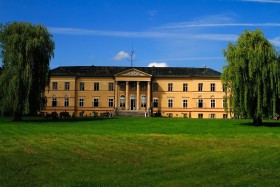Music Museum SNM, Bratislava
 The Music Museum SNM in Bratislava is a documentary, science and research institution as well as methodological museum workplace with a nationwide scope that collects, protects, professionally handles, uses and opens up museum collections of a musical character documenting the field of musical culture from the earliest time until the present.
The Music Museum SNM in Bratislava is a documentary, science and research institution as well as methodological museum workplace with a nationwide scope that collects, protects, professionally handles, uses and opens up museum collections of a musical character documenting the field of musical culture from the earliest time until the present.
The museum works in a network of international musical and documentary institutions (International Association of Music Libraries, Archives and Documentation Centres (IAML)), it is a central workplace for the evidece and processing of preserved musical sources in the territory of Slovakia and also a national head office of the international catalogue of musical sources (Répertoire International des Sources Musicales (RISM)).
The Music Museum, which was founded in early 1991, develops the results of work and activities of the Music Department of the Museum of History SNM. In 1965 there arose the first specialised music and documentation workplace in Slovakia – the Music Department of the Institute of the Slovak National Museum. The Music Department later separated and in 1991 a separate Music Museum was set up under the Slovak National Museum.
The beginnings of its activities can be dated even before the year 1965. In the years 1953-1958 an expert worker of the Slovak Museum in Bratislava, Professor Juraj Šimko-Juhás, collected in several musical instruments and musical compositions which later became an important part of the future museum. He also planned to establish a Slovak music museum in the mansion in Dolná Krúpa, referring to the Beethoven’s tradition there. Even though Professor Šimko-Juhás did not manage to set up a museum we can consider him to be one of the founders of the Music Museum. This phase lasted many years until the mansion was renovated and started to be used by musical institutions. In 1978 it was opened to the needs of the Home of Slovak Composers and then in 2003 it finally became part of the Slovak National Museum.
Since the establishment of the Music Department, expert workers of the museum have gathered many remarkable collections. The activities of the workplace were formed mostly by the musicologists Dr Ľuba Ballová, CSc. (1965-1990), Dr Ivan Mačák (1965-2002), Dr Vladimír Čížik, CSc. (1966-1991), Dr Darina Múdra, DrSc. (1966-1989), Dr Viola Fedorová-Švantnerová (1977-1992), Dr Alexandra Tauberová (1978-2001), Judita Frešová (1981-1990), Dr Danica Štilichová (since 1983), Dr Jana Kalinayová-Bartová (1988-2002) and many others.
The Music Museum has recently organised some presentation activities including the following exhibitions: Musical Instruments in Slovakia (1975-1986, I Mačák), Important Representatives of European Music and Slovakia (1979-1992, V Švantnerová), Ludwig van Beethoven in Slovakia (1992-2004, Ľ Ballová) and Musical Instruments Heritage (1995 -2003, I Mačák). Exhibitions aimed at musical culture in relation to Slovakia were prepared by: V Čížik (B Bartók, 1969; L Janáček, 1980) and A Tauberová (F Liszt, 1986). Several exhibitions devoted to the presentation of musical instruments have from time to time been organised by I Mačák, who set up a remarkable collection of musical Instruments with particular representation of traditional folk instruments.
 In 1980s on the premises of the mansion in Dolná Krúpa a depositary was built by extending the space of a former orangery. The collection of musical instruments was situated in this depository. Other important exhibition projects held in the 1990s, following the separation of the museum, include: Bases of Musical History (J Kalinayová-Bartová, 1996) and The Double-portrait – E Suchoň (D Štilichová, 1998). In the first decade of the new millennium the museum has undergone several changes: It has taken under its own supervision the whole premises of the former estate in Dolná Krúpa including the mansion (2003). The original Bratislava workplace, situated at Bratislava Castle, was moved from the premises of the castle because of the renovation of northern walls and collections of an archival nature were relocated to the depositary in Dolná Krupá (2008). When the founding generation of the museum left, there appeared other expert workers who have since established themselves in the music-museum field as well as eg Miriam Lehotská (since 1996), Zlatica Kendrová (since 2000), Sylvia Urdová (since 2001), Mária Krajčiová (since 2001), Dr Edita Bugalová (since 2002), Peter Jantoščiak (since 2005), Dr Tomáš Surý (since 2008) and conservator Brigita Hradská (since 1990). In this period several exhibition projects were prepared. There were some exhibitions devoted to the individual representatives of Slovak music: On the Road of Professionalism – A Moyzes (M Krajčiová, K Sirotňáková, 2002), Ján Levoslav Bella (J Bartová, 2003), Mikuláš Schneider-Trnavský (E Bugalová, 2006) and Eugen Suchoň (D Štilichová, 2008). Items from the collection of musical instruments were displayed through the following exhibitions: The Preserved Sound (E Bugalová, 2004) and The Reflection of Classicism (P Jantoščiak, Z Kendrová, 2007). The topic of popular music also got its chance through the exhibition Jaro Filip at the Castle (L Fojtíková, 2005).
In 1980s on the premises of the mansion in Dolná Krúpa a depositary was built by extending the space of a former orangery. The collection of musical instruments was situated in this depository. Other important exhibition projects held in the 1990s, following the separation of the museum, include: Bases of Musical History (J Kalinayová-Bartová, 1996) and The Double-portrait – E Suchoň (D Štilichová, 1998). In the first decade of the new millennium the museum has undergone several changes: It has taken under its own supervision the whole premises of the former estate in Dolná Krúpa including the mansion (2003). The original Bratislava workplace, situated at Bratislava Castle, was moved from the premises of the castle because of the renovation of northern walls and collections of an archival nature were relocated to the depositary in Dolná Krupá (2008). When the founding generation of the museum left, there appeared other expert workers who have since established themselves in the music-museum field as well as eg Miriam Lehotská (since 1996), Zlatica Kendrová (since 2000), Sylvia Urdová (since 2001), Mária Krajčiová (since 2001), Dr Edita Bugalová (since 2002), Peter Jantoščiak (since 2005), Dr Tomáš Surý (since 2008) and conservator Brigita Hradská (since 1990). In this period several exhibition projects were prepared. There were some exhibitions devoted to the individual representatives of Slovak music: On the Road of Professionalism – A Moyzes (M Krajčiová, K Sirotňáková, 2002), Ján Levoslav Bella (J Bartová, 2003), Mikuláš Schneider-Trnavský (E Bugalová, 2006) and Eugen Suchoň (D Štilichová, 2008). Items from the collection of musical instruments were displayed through the following exhibitions: The Preserved Sound (E Bugalová, 2004) and The Reflection of Classicism (P Jantoščiak, Z Kendrová, 2007). The topic of popular music also got its chance through the exhibition Jaro Filip at the Castle (L Fojtíková, 2005).
In 2004 a permanent exhibition in the. Beethoven Monument in Dolná Krupá was reopened (prepared by Ľ Ballová and E Bugalová). It was later extended by new information on life of the Brunsvik and Chotek families based on knowledge gained through deeper archival research (performed by T Surý in 2008-2009). In 2003 the workers of the museum installed the following long-lasting exhibitions: When the Signal Rings (S Urdová), Fontes musicae hymnicae (Z Kendrová) and In Musical Dialogue - the Albrecht family in Bratislava (M Lehotská).
The latter exhibition was closely connected with one of the largest acquisitions of the museum (more than 20,000 pieces) – the objects of the Albrecht family, collected in the years 2003-2008. Precious acquisitions of the museum also include the collection of monuments of an archival nature from the 14th-19th centuries which the museum gained through the transfer from the Institute of Musicology, Slovak Academy of Sciences.
During the second decade of the existence of the separate Music Museum its collection fund was extended by 28,910 items. By the first half of 2010 the total number of articles in collections amounted to 122,648 items. According to this criterion the Music Museum is one of the largest museums in Slovakia. The collection of musical instruments itself is represented by more than 2,600 registered items and constitutes one of the largest collections of its kind in Central Europe. In the last decade the museum has co-operated in various international projects; the most distinguished of these was the exhibition Desatoro o fujare (The Ten Commandments on Fujara, curator P Jantoščiak, 2006), which was organised on the occasion of the inscription of this instrument into the UNESCO List of Intangible Cultural Heritage. This exhibition was held in different locations in Slovakia, as well as in Paris, Berlin and Budapest. In 2007 when the European Capital of Culture was Transylvanian Sibiu, the Music Museum hosted the exhibition Ján Levoslav Bella in Sibiu, prepared on basis of the former archival research of Bella’s objects in Romania (J Bartová, E Bugalová).
The editorial activities of the museum have declined somewhat recently because of the limited amount of financial sources. The remaining editorial outputs are mostly connected with exhibition projects (eg catalogues for the exhibitions The Ten Commandments on Fujara and Eugen Suchoň 1908-2008). In 2008 the museum in co-operation with Slovak Musicological Association and the St Vojtech’s Society published a memorial volume devoted to the 70th anniversary of the Unified Catholic Songbook.
As far as the evidence and documentation are concerned the Music Museum belonged as early as in the 1980s to pioneers in the attempts to make the evidence of funds electronic. It is recently one of the participants in the project of funds processing through the Central Museum Collection Evidence and it is gradually abandoning traditional forms of documentation.
